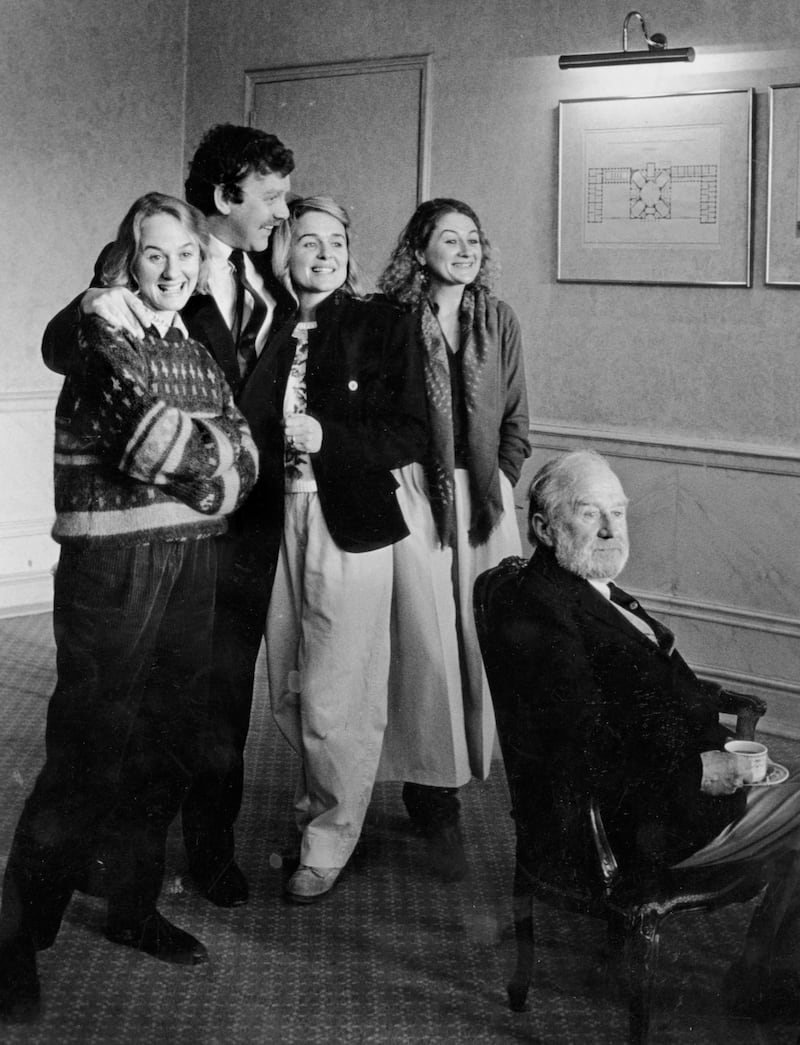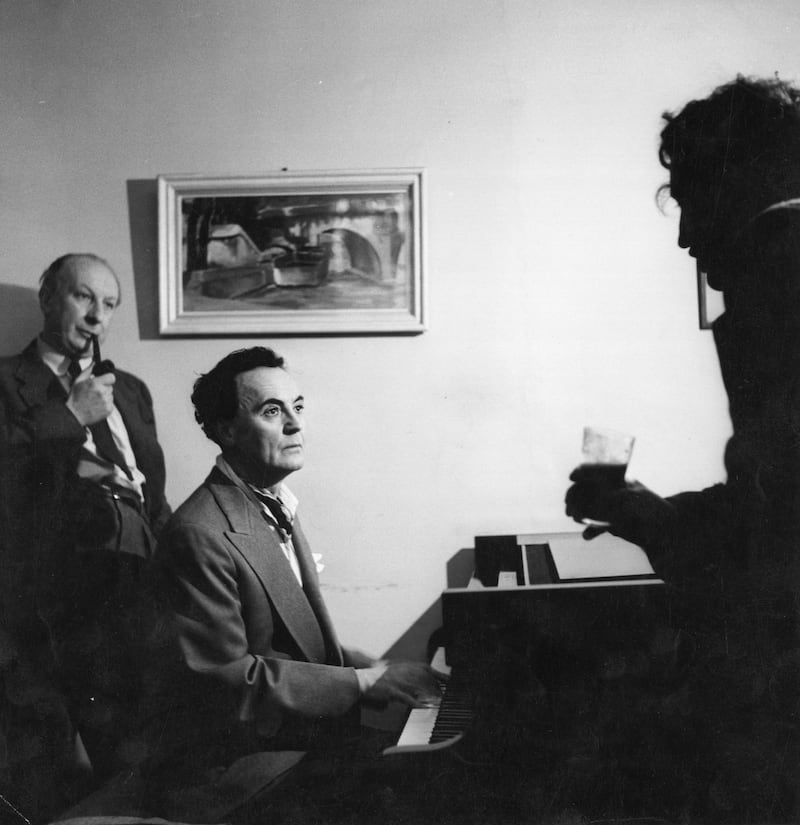On a recent afternoon in Dublin, which the spring sunshine had made seem for a moment like a different city, Selina Cartmell ascended, via a rust-covered ladder and across moss-blemished shingles, to the roof of the Gate Theatre.
In the building’s almost 90-year history this has not been a frequented spot. But, with clear views in every direction, it was worth the effort. There were tranquil sights northwards of the Garden of Remembrance, a clogged O’Connell Street towards the shimmering Liffey to the south and, on either side, the clatter of Luas developments and the ever-burgeoning Chinatown along Parnell Street: in every sense a city under construction.
Cartmell, who was announced in October as the new artistic director of the Gate Theatre – making her only the fourth in its long history – and who begins her tenure this month, had made the climb for a photograph. But she admitted that it was a good place to clear her head after five intensive months working towards delivering her first programme for the theatre, which will be revealed next month. The vantage also seemed to suit her artistic approach, whether towards performance or understanding organisations, by recognising what has always been there and still seizing a fresh perspective.
You could argue that Cartmell, a director celebrated for her striking and darkly compelling stage visions, for reinvigorating classic texts and for working across disciplines, has been doing something similar for most of her career. Cartmell is a three-time winner of the Irish Times Irish Theatre Award for best director. This has included her work with her own company, Siren Productions, and as a gun for hire. (She has worked for the Gate, the Abbey, the Lyric and many others.) Cartmell tends to crack open plays, and often performance spaces; to point out things that might otherwise be overlooked.
In the chatter that nudged and guessed at potential successors to Michael Colgan, who served as artistic director for 33 years, Cartmell's name was not prominent, partly because the interview process had been well guarded but also because it has been a decade since she last directed at the Gate, with 2007's brilliantly imaginative Sweeney Todd. If her appointment conveyed immediate sense it was partly because her work often comes with a velvety aesthetic commensurate with the building but also because her productions at the Gate artfully teased out the theatre's untapped potential.
Mischievous
In 2006 a starkly beautiful and faintly mischievous staging of Samuel Beckett's Catastrophe, as part of the playwright's centenary, found glancing parallels between an imperious director and his scuttling assistant and the management of the theatre. The same year her staging of Festen, a contemporary revenge tragedy adapted from Thomas Vinterberg's film, extended the grand fittings of the Gate's building into its stage design while wittily subverting some of the theatre's ornate conventions. The safety announcement, for example, was delivered by a stern person who then climbed onstage to join the action, and at its finale, which comes with a burst of daybreak, windows hidden high in the auditorium walls where thrown open to let new light into the theatre. Thinking back, it's hard not to see this as either a potential new mission statement or a very sly job application.
“It’s excavating, isn’t it?” Cartmell says of her approach to directing, in a room flooded with sunlight across the street from the theatre. “You have to shine a light into the corners.”
The hotel where we meet, Cassidys, was once a haunt of Micheál Mac Líammóir and Hilton Edwards, the Gate's founders and first artistic directors, where they devised early programmes for their new theatre in the Rotunda buildings. Cartmell's conversation was likewise suffused with its history, whether scholarly or casual. (Pulling the curtain to shield the eyes of a visitor, she surveyed the shadows and decided, "You look like Orson Welles there.")
What the Gate will look like under Cartmell’s stewardship is the question on everybody’s mind. Mac Líammóir and Edwards developed a modernist European repertoire, a programme that could include Ibsen, Wilde, O’Neill, Chekhov, Strindberg and Shakespeare, and it won acclaim as a directors’ theatre. Next to the rural and naturalist fixations of the Abbey at the time, this gave rise to the joke that Dublin theatre was divided “between Sodom and Begorrah”.

Colgan preserved much of that repertoire, together with a focus on prestige productions and starry casts, festivals that celebrated Beckett, Harold Pinter and Brian Friel, and a programme that liberally raided the costume dramas of Oscar Wilde, Noel Coward and Pride and Prejudice, while less frequently engaging with new writing. So where is the Gate headed now?
“The Gate was established as an international classical theatre,” Cartmell says, “and I think that needs to remain as the spine of the programme.”
Where others may see limitations – a proscenium-arch stage with ornate plasterwork and more chandeliers than some palaces – Cartmell sees liberation.
"It's like a Beckett play," she says. "In Happy Days Beckett's instruction for Winnie is very specific: 'She looks up to the zenith.' But there are a hundred ways to look up to the zenith."
Room to manoeuvre
It’s an interesting comparison, because Winnie, buried up to the waist and later up to her neck, has very little room to manoeuvre. The Gate comes with an imposing history and an inflexible architecture, but, more than most theatres, it also comes with a particular audience: older, affluent, with particular expectations. Even Colgan could fall foul of its tastes. Operating on 75 per cent attendance in order to break even, Colgan admitted a couple of years ago that programming Wilde had saved his skin several times, whereas one production with a youthful orientation (of which he was more proud) had been so poorly attended that the theatre would “be paying for it for two years”. The Gate’s audience was expertly cultivated but seldom replenished.
How much of the theatre’s culture is an inheritance that must be honoured and how much can it be challenged?
“I think it’s about both continuity and change,” says Cartmell, who admits that, where she once railed against programmes for not being fearless enough, she now adopts some caution. “It would be totally foolish of me to rip it all up, and start again, because that loyal Gate audience is as important to me as the new audiences that could potentially be coming into the Gate as well.”

One practical step will be to recalibrate the schedule.
“One of my ambitions – and this won’t happen overnight – is to look at ways that the length of runs can be shortened in order to look at maybe a more eclectic programme of work,” she says.
That is also what the new directors of the Abbey, Neil Murray and Graham McLaren, are instituting, a further indication that the nation’s major theatres now have more in common than a dusty joke.
Cartmell is likewise planning longer cycles than her predecessor, who rationed out details of his schedule just weeks ahead of each opening. When Cartmell’s first programme is announced, on May 17th, it will hold details of productions into 2018 – and possibly beyond.
“It’s kind of a mix of the old and the new” is all she will allow until then. “I hope it will keep some of the great traditions of the Gate but offer a fresh twist on those stories. It will, hopefully, feel more urgent and relevant in terms of the relationship between artists and audiences.”
Commissions and collaborations
There are other ways to open up the Gate, though. Cartmell is keen to commission new work from Irish artists, especially women, while inviting international artists into collaboration. (She is likely to direct there herself, once she can balance the requirements of being the artistic director.) The Gate Lab, moreover, in the handsome new wing of the theatre, was pitched as a point of intersection between the theatre and the independent sector for developing work, but it has functioned more often as the Gate’s rehearsal venue.
“That space needs to be the heart of the Gate,” she says. “I’m absolutely committed to that. That’s an absolutely perfect way of putting artists at the centre of the Gate’s programme on so many levels. Something I’m really passionate about is to create an environment where artists feel 100 per cent supported. I hope they will feel it is a theatrical home for them to create their strongest work, their most inspired work; that it feels less like a place where you work for just one or two shows, and more like a journey to go on.”
Journeys, in Cartmell's conversation, are more than just talk. She is less inclined to attribute to chance the discoveries made in a play or the points along a career path, instead determining connections, if only in retrospect. She never anticipated running the Gate, but she traces a reassuring trail from seeing the Gate's Beckett festival in London, being propelled to Trinity College Dublin to pursue a thesis on the writer, and later attending rehearsals for Walter Asmus's Waiting for Godot and assisting another of the theatre's renowned associates, Steven Berkoff.
“So there’s been a series of little connections for me, even prior to directing at the building in the first place, which I find interesting,” she says. “It just feels comforting. I don’t think it’s serendipity. I don’t think any of this is. And I feel – with Orson Welles, Berkoff, Beckett – that the Gate attracts drifters. I think it is a little bit of the flame for those moths.”
That may explain how she conceives of the theatre and its new adventure, recognising what is already there while offering a fresh perspective. She shifts her gaze through the window back up towards the Gate’s rooftop.
“It’s about more than the building,” she says. “I think there is a way that the theatre can really have an impact, in terms of the work, but also beyond that. For me it’s about making it a beacon.”


















